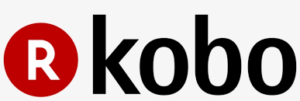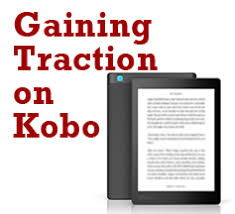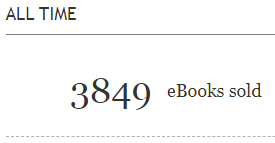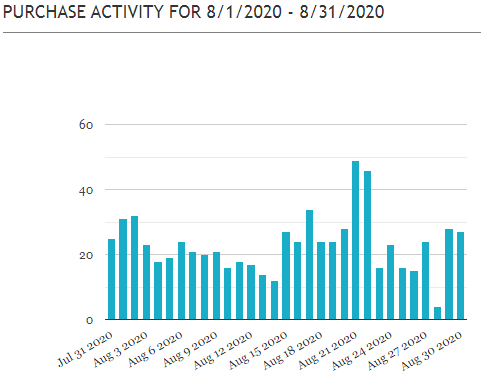Eight years ago, if I told you I was an internationally-published indie author with a global scale you’d go, “Right. You can’t find an agent or traditional publisher to peddle your pages so you’re forced to self-pub through a vanity press and you mailed five copies to your Scottish-bred mother.” I’d lower my eyes and mumble, “…. …” Today, that’s no longer my self-conscious indie state—thanks to Kobo.
Kobo (an anagram for Book) is a godsend for indie authors like me who operate a growing online publishing business. I avoid the word “self-publishing” because no one in this business truly publishes by themselves. It takes a team to produce a book, whether that’s in print, eBook, or audio form. That includes a cover designer, editor, proofreader, formatter, narrator, writer, and of course, the folks at Kobo who distribute the final product to a worldwide reading audience.
 Before going into how Kobo operates and what Kobo has done for me, let me tell you a bit about this leading-edge publishing company. Kobo started in 2009. It was a Toronto, Canada-based online start-up promoting ShortCovers as a cloud e-reading service for Indigo/Chapters. In 2012, Kobo merged with the Japanese e-commerce conglomerate Rakuten, and the e-publishing company is now officially listed as Kobo-Rakuten Inc. Most call it Kobo for short.
Before going into how Kobo operates and what Kobo has done for me, let me tell you a bit about this leading-edge publishing company. Kobo started in 2009. It was a Toronto, Canada-based online start-up promoting ShortCovers as a cloud e-reading service for Indigo/Chapters. In 2012, Kobo merged with the Japanese e-commerce conglomerate Rakuten, and the e-publishing company is now officially listed as Kobo-Rakuten Inc. Most call it Kobo for short.
Kobo has grown enormously in the past eight years. It’s absorbed brand-names like Waterstones, Borders, Sony Books, and W.H. Smith. In 2018, Kobo partnered with Walmart intending to make Amazon nervous. After all, Rakuten is the Asian version of the American ’Zon.
Today, Kobo-Rakuten has well over 5 million titles in their store. They’re available online in 190 countries and 97 different languages. If that isn’t a truly international indie-publishing platform, then I don’t know what is.
How Kobo is Structured
Kobo-Rakuten focuses on its core products. That’s electronic publication. Their business model, or structure, has three parts. One is digital printing or eBooks. Two is electronic audio books. Three is electronic reading devices like Kobo e-readers and Kobo tablets. At this time, Kobo does not do print-on-demand like Amazon and Ingram. That may happen through Walmart’s Espresso machines.
Kobo’s corporate statement says it’s a “company built by booklovers for booklovers through talented and passionate people taking the top of their game to the next level”. Kobo’s primary management team is in Toronto, and it has a prominent software development division in Dublin, Ireland. International sub-teams work in the US, UK, France, Germany, The Netherlands, Spain, Japan, Brazil, and Australia.
Besides corporate white-shirts and hipster geeks, Kobo has a down-to-earth bunch of ladies in their reader and writer service department. It’s these with-it women that an indie like me communicates with. And by communicate, I mean I can send them an email or arrange a phone call and I’ll get prompt human contact with someone whose accent I understand.
Publishing on Kobo
I have indie-publishing experience in three electronic platforms—Amazon, Barnes & Noble, and Kobo. I’m here to tell you that Kobo is far superior to the other two when it comes to diminished operator frustration. I think the Kobo techs must indie-publish themselves because they’ve built a dashboard that doesn’t suck.
Kobo’s user-friendly dashboard has five distinct parts laid-out in this easy-to-follow order:
Part 1 Describe Your Book — This is where you enter “metadata” into the boxes. It’s basic information like title, series number, author name, publisher, ISBN, etc. You’re allowed up to three placement categories to check off from a comprehensive drop-down list. You also copy & paste your synopsis (product description/blurb) into an html-friendly format. It’s far better than Amazon’s product description block that makes you write html by letter-code.
Part 2 Add Your eBook Content — Here is where you upload your manuscript e-file. Kobo is so easy to add content to. Unlike Amazon that dictates a proprietary e-file called Mobi or AZW, Kobo lets you upload a Microsoft document directly, and it uses its own e-Pub conversion program to convert your document into an e-Pub file. Kobo will convert .doc, .docX, .mobi, and .ode files automatically. They also have a pay-to-convert affiliate called Aptara.
Note: If there’s one secret to successful Word-to-e-file conversion, it’s making sure your Word.doc is properly formatted to start with. This is crucial! I covered the steps in a previous Kill Zone post titled Top Ten Tips on Formatting eBooks From MS Word. Once your file is uploaded to Kobo, they have a one-click preview feature.
Part 3 Determine Your Rights and Distribution — This is straightforward but necessary metadata. Leave your Digital Rights Management (DRM) slide off. Activate your slide for Geographic – Own All Territories. Allow Kobo Plus Subscription. (This is akin to Amazon’s Kindle Unlimited (KU). It’s only available in a few countries but will probably go worldwide.) Also, allow library purchases through Overdrive. Just make sure to increase your price from your regular retail listing. If libraries want your works, they’ll gladly pay $4.99 instead of $2.99. (It’s called a profit center.)
Part 4 Set Your Price — Setting your price point is entirely up to you. It depends on what you think you can charge to get the maximum return from sales. I’ve found my sweet spot is $2.99 per e-Book. If I bump up the price to $3.99 or $4.99, I find my sale numbers drop considerably so I actually make less net income by charging more.
I’ve refined my eBook prices to $2.99 everywhere. That includes all publications on Amazon (20 eBooks), Kobo (8 eBooks), and Barnes and Noble (7 eBooks). I have one perma-free on all platforms, and I could write another entire post on how beneficial perma-frees can be.
Kobo pays 70% royalty on $2.99 and over which is the same as Amazon. Drop below $2.99 and Kobo pays 45% where Amazon squeezes you to 30%. Them’s the rules… and so you must play.
 A distinct advantage of publishing “Wide” with Kobo is they won’t penalize you if you’re not exclusive the way Amazon enslaves you under the Kindle Direct Publishing Select (KDPS) program. Trust me. The advantages you lose by moving off exclusive KDPS are far exceeded by publishing perks on Kobo. The only issue might be if you have a large KU page reading and you’ll stop this income stream if you go wide. I didn’t, and I have absolutely no regrets going Wide and hooking up with Kobo.
A distinct advantage of publishing “Wide” with Kobo is they won’t penalize you if you’re not exclusive the way Amazon enslaves you under the Kindle Direct Publishing Select (KDPS) program. Trust me. The advantages you lose by moving off exclusive KDPS are far exceeded by publishing perks on Kobo. The only issue might be if you have a large KU page reading and you’ll stop this income stream if you go wide. I didn’t, and I have absolutely no regrets going Wide and hooking up with Kobo.
I’ve been told that using the “.99” trick is important when pricing eBooks, and I believe it. This is a tried & true marketing technique that’s been around forever. That’s because it works. Kobo is truly an international publishing platform that allows you to set individual prices per country and in its currency. Kobo also has an automatic currency converter built-in to the dashboard. However, don’t let Kobo automatically convert and post a $2.99 USD equivalent in a foreign currency or it’ll look like doggy-doo with ugly-weird figures, ie 2.31, 8.47, 28.01, etc.
To get the 70% royalty at $2.99 USD and keep with the “.99” strategy, here’s how I manually set pricing on my Kobo international dashboard:
United States Dollar – 2.99
Canadian Dollar – 2.99
United Kingdom Pound – 2.99
Australian Dollar – 2.99
New Zealand Dollar – 2.99
Brazilian Real – 9.99
European Euro – 2,99
Hong Kong Dollar – 19.99
Indian Rupee – 99.99
Japanese Yen – 299.00
Mexican Peso – 99.99
New Taiwan Dollar – 79.99
Philippine Peso – 99.99
South African Rand – 29.99
Swiss Franc – 2.99
By the way, Kobo pays in half the time Amazon does. You’ll receive your Kobo direct deposit 45 days after the last day of the month. This becomes a monthly cycle and is disbursed provided you make at least $50.00 in sales during that period. Otherwise, Kobo will defer payment until you have a $50.00 payable account. Don’t worry about not getting paid if you have a slow month. It’s like money in the bank, and it motivates you to promote sales and get regular checks.
Kobo Promotions
Kobo has a unique promotion program built into your dashboard. When you first open a Kobo account, the promo tab won’t appear. You have to send Kobo a quick email request and… presto! It’s there and really easy to understand, never mind use.
Kobo’s internal e-Book promotion system is entirely pay-to-play. You have to apply for a particular Kobo promotion feature and you get declined more times than accepted. Looking at my Kobo dashboard, I have 2 active promos running, 1 forthcoming, 7 completed, and I was declined 19 times. Don’t get hurt feelings over being declined for a Kobo promotion. You have to apply quite a bit in advance (2-4 weeks) and they’ll overlook you if they think you’re trying to game or monopolize the system by hogging spots. It didn’t take me long before I got that memo.
Kobo has two promotion packages. One is a flat rate where you pay a fixed-fee (up-front) for a particular exposure. Two is a shared percentage based on sales volume that’s deducted from your pay. Here’s a sample of Kobo promotions and costs:
Daily Deal Homepage – $100.00 flat rate
Free Page – Fiction and Non-fiction – $5.00 or $10.00 flat rate
Double Daily Deal – 10% share
First in Series – $10.00 or $30.00 flat rate
Editor’s Pick – $30.00 flat rate
Kobo has no restrictions about you running independent ads on the email list discount sites. You just have to make sure you adjust your Kobo price to match your privately-advertised promo price. If you don’t, they’ll cut your Kobo promo in a flash. The algorithm-powered bots have a way of knowing this… so be diligent here.
Be aware that “FREE” is the most-searched word in Kobo’s engine. Kobo readers love their free stuff, and it’s a wise move to offer a freebie from time to time… or a .99 cent discount. I only have one free book on Kobo. That’s the first in a multi-book series, and it’s a very profitable loss-leader. The read-through sales rate triggered by a free offering is significant.
Kobo Resources
Kobo-Rakuten is here to help indie authors and publishers. The Kobo dashboard has great links to all sorts of practical assistance. The “live voice” is also only a click or call away. Value-added author/publisher services on the dashboard include:
ISBN issuance
Review sources
Cover designs
Editor referrals
Language translation
Rights management
Audio book recording
Kobo has another excellent writer/publishing portal. It’s called Kobo Writing Life (KWL) which is a blog about writing and self-publishing. Besides the dozens and dozens of helpful posts, KWL has an excellent podcast series featuring their help-ladies, inspiring success stories, and featured events.
So, how is Garry Rodgers Doing on Kobo?
Very well, thank you. That’s considering the short time I’ve been indie-publishing there. I was told by other Kobo indies to be patient and promote. They said it takes a while to gain Kobo traction… give it six months before assessing Kobo’s worth, they said.
It’s been six months now. I put out my shingle at Kobo on April 24, 2020. The first bit… crickets… nuthin’… zilch. Then, I ran some strategic promotions and Kobo took right off for me. I originally started with 5 Kobo publications. I added 3 more eBooks in the summer and, by August 2020, it was all worthwhile.
 In July and August, I ran “stacked promotions” on Kobo along with paid ads on sites like Booksy, EReader News Today, and Robin Reads. My Kobo sales jumped to an average of around 20 downloads per day or 600 for the month. Now, in mid-October, I’ve had 3,849 all-time Kobo downloads in 68 international markets. This is growing exponentially, and it’s key to eBook sales success. It’s the same principle as compound interest.
In July and August, I ran “stacked promotions” on Kobo along with paid ads on sites like Booksy, EReader News Today, and Robin Reads. My Kobo sales jumped to an average of around 20 downloads per day or 600 for the month. Now, in mid-October, I’ve had 3,849 all-time Kobo downloads in 68 international markets. This is growing exponentially, and it’s key to eBook sales success. It’s the same principle as compound interest.
Here are stats on where Kobo sold books for me in the last 6 months. Note: These figures include all regular priced sales and discounted promotions.
Canada – 1817
United States – 510
United Kingdom – 466
Australia – 290
South Africa – 160
New Zealand – 106
India – 69
Netherlands – 45
Nigeria – 33
Ireland – 30
The remaining 58 countries range from 1 to 30 downloads each. In no particular order, they are:
Mexico, Jamaica, Dominican Republic, St. Vincent & Grenadines, Trinidad & Tobago, Colombia, Ecuador, Argentina, Brazil, Tonga, Belgium, Germany, Andorra, France, Denmark, Portugal, Spain, Switzerland, Greece, Romania, Italy, Croatia, Slovenia, Austria, Hungary, Turkey, Morocco, Algeria, Tunisia, Malta, Libya, Israel, Lebanon, Egypt, Saudi Arabia, Qatar, United Arab Emirates, Oman, Ghana, Uganda, Zambia, Namibia, Zimbabwe, Mauritius, Cocos Islands, Turkmenistan, Pakistan, Nepal, Bangladesh, Thailand, Vietnam, Hong Kong, Japan, Philippines, Malaysia, Singapore, and Indonesia.
Kobo is a Truly International Indie-Publishing Platform
A marvelous feature built into Kobo is their deep-analytics distribution map of the world. It shows your total sales volume per country represented in blue circles. The bigger the circle, the more books you’ve sold in that country. The more circles you have on the world map, the wider your global distribution is. You can custom-adjust your stats review by the day, the week, the month, or all-time.
Seeing my Kobo sales growth is encouraging and rewarding. I still have limited experience in Kobo publishing, but what I’ve found is consistent with what more experienced (and much more successful) indies have told me about working with Kobo. These are the factors that’ll make Kobo work for you on an international scale… not possible with any other publisher:
Multiple Products — This includes eBooks and audio books (which I haven’t tried yet). It’s unrealistic to expect decent and expanding sales figures from one stand-alone product. Indie writing and publishing is a “numbers game”. The more products you offer for sale, and the more platforms you offer them on, the more you stand to sell.
Series Production — Most of my Kobo downloads are in a series. I have 6 books in a Based-On-True Crime Series and 2 stand-alone products offered on Kobo. The series beats the stand-alones ten-fold. I see a read-through sales pattern, and it’s growing with more readers recognizing my brand and being confident enough to buy into it.
Pay-To-Play — You have to spend money to make money in the indie writing and publishing business. Paid promotions work. That includes Kobo’s in-house program (which isn’t expensive) and boosting the Kobo promos with “stacked” independent ads. Those include the discount email sites and click-through ads on BookBub. I haven’t tried FaceBook yet, and Amazon won’t allow you to say “Kobo” in their presence.
A Positive Indie Author/Publisher Mindset — This is the most important factor of all. Once I made the decision (February 17, 2020) to treat my indie writing and publishing as a business, things really changed. It takes time and persistence, but it’s worth it. It fits with this quote I have on my writing space wall:
Until one is committed, there is hesitancy, the chance to drawback. Concerning all acts of initiative (and creation), there is one elementary truth that ignorance of which kills countless ideas and splendid plans: that the moment one definitely commits oneself, then Providence moves, too. All sorts of things occur to help one that never otherwise have occurred. A whole stream of events issues from the decision, raising in ones favor all manner of unforeseen incidents and meetings and material assistance, which no one could have dreamed would have come their way. ~ Johan Wolfgang von Goethe
How about you Kill Zoners? Do you have any words to share about Kobo or writing and publishing in general? Let us know in the comments!
——
 Garry Rodgers is a retired homicide detective with a second run as a forensic coroner investigating unexpected and unexplained human deaths. Now, Garry has reinvented himself in a third career as an indie author/publisher and admits at struggling to make sense of it all.
Garry Rodgers is a retired homicide detective with a second run as a forensic coroner investigating unexpected and unexplained human deaths. Now, Garry has reinvented himself in a third career as an indie author/publisher and admits at struggling to make sense of it all.
When not being indie, Garry Rodgers spends his of time putting around the Pacific saltwater near his home on Vancouver Island in British Columbia at Canada’s west coast. Follow Garry’s regular blog at DyingWords.net and connect with him on Twitter and Facebook.



